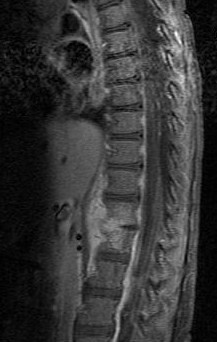Discitis
| Discitis | |
|---|---|
 |
|
| Discitis in a 2 year old child. | |
| Classification and external resources | |
| Specialty | rheumatology |
| ICD-10 | M46.4 |
| ICD-9-CM | 722.90 |
| DiseasesDB | 3847 |
| MedlinePlus | 000993 |
| eMedicine | article/1263845 |
| MeSH | D015299 |
Discitis or diskitis is an infection in the intervertebral disc space that affects different age groups. In adults it can lead to severe consequences such as sepsis or epidural abscess but can also spontaneously resolve, especially in children under 8 years of age. Discitis occurs post surgically in approximately 1-2 percent of patients after spinal surgery.
Symptoms include severe back pain, leading to lack of mobility. Some very young children may refuse to walk and arching of the back is possible. In post-operative situations, the symptoms occur within a week and result in severe low back pain or neck pain (depending on the surgical location). If untreated, the discitis may resolve on its own, causing spontaneous fusion of the intervertebral disc space, cause a chronic low grade infection, or progress to osteomyelitis and possibly even an epidural abscess. In case of concomitant inflammation of one or more vertebrae (in such cases usually the areas adjacent to the intervertebral disc spaces) the condition is called spondylodiscitis.
There is debate as to the cause, although hematogenous seeding of the offending organism is favored as well as direct spread. It is important to differentiate between spontaneous discitis which is usually from hematologic spread from a urinary or respiratory infection versus that from a post-operative complication which usually involves skin flora such as staph aureus. It can be caused due to spinal tuberculosis and spread along spinal ligament to involve the adjacent anterior vertebral bodies, causing angulation of the vertebrae with subsequent kyphosis.
The cause may be aseptic.
Diagnosis is usually apparent on MRI although plain X-rays and CT examinations can be suggestive. The MRI will reveal air changes in the disc and possibly even external involvement involving the bone or epidural regions. A biopsy may be performed and helps with diagnosis in some cases but often an organism is not obtained. C-reactive protein levels and ESR levels will be elevated and are useful for treatment. Often, the white blood cell count will be normal and the patient will be afebrile.
...
Wikipedia
